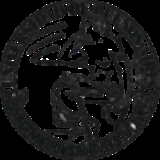
University of Buenos Aires
Encyclopedia
The University of Buenos Aires is the largest university
in Argentina
and the largest university by enrollment
in Latin America. Founded on August 12, 1821 in the city of Buenos Aires
, it consists of 13 faculties, 6 hospitals, 10 museums and is linked to 4 high schools: Colegio Nacional de Buenos Aires
, Escuela Superior de Comercio Carlos Pellegrini
, Instituto Libre de Segunda Enseñanza
and Escuela de Educación Técnica Profesional en Producción Agropecuaria y Agroalimentaria.
To enter any of the available programmes of study in the university, students who have successfully completed high school must pass a first year called CBC, which stands for Ciclo Básico Común (Common Basic Cycle). Only upon completion of this first year may the student enter the chosen school; until then, they must attend courses in different buildings, and have up to 3 years to finish the 6 subjects (which vary depending on the programme of study chosen) assigned in two groups of 3. Each subject is of one quadrimester duration (March–July or August–November). If someone passes all 6 subjects in their respective quadrimesters, the CBC will take only one year. Potential students of economics, instead, take a 2-year common cycle, the "CBG" (General Basic Cycle), comprising 12 subjects.
The UBA has no central campus
. A centralized Ciudad Universitaria (literally, "university city") was started in the 1960s, but contains only two schools, with the others at different locations in Buenos Aires.
Access to the university is free of charge for everyone, including foreigners. However, the postgraduate programs charge tuition fees that can be covered with research scholarships for those students with outstanding academic performance.
It is currently the best ranked Argentine university in college and university rankings
, present at number 197 of the Top Universities 2008 and at number 151-200 of the 2010 Shanghai Jiao Tong University
ranking
. It has produced more Nobel Prize
laureates (four) than any other Spanish-speaking
University except the Complutense University of Madrid
. In 2010, according to University Ranking by Academic Performance (URAP), University of Buenos Aires is the best university in Argentina and 247th university in the world.
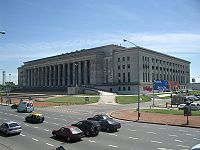
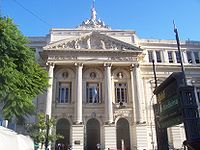
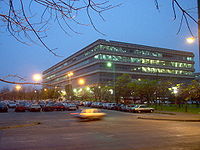
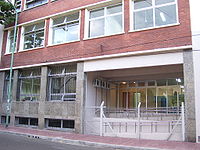
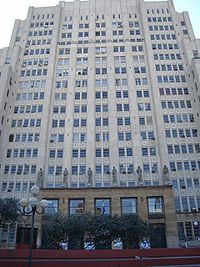


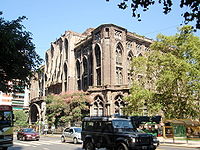 The Schools that comprise the university are:
The Schools that comprise the university are:
Of these, only the last two have their buildings located in Ciudad Universitaria, a campus-like location in Núñez
, in northern Buenos Aires. The others are scattered around the city in buildings of various sizes, with some having more than one building. There are projects to move more schools to Ciudad Universitaria, the first one in order of importance is the School of Psychology, whose building is already designed to be placed on this Campus.
The following former students and professors of the university have received the Nobel Prize
:
The following Presidents of Argentina
have earned their degrees at the university:
University
A university is an institution of higher education and research, which grants academic degrees in a variety of subjects. A university is an organisation that provides both undergraduate education and postgraduate education...
in Argentina
Argentina
Argentina , officially the Argentine Republic , is the second largest country in South America by land area, after Brazil. It is constituted as a federation of 23 provinces and an autonomous city, Buenos Aires...
and the largest university by enrollment
World's largest universities
This list of largest universities by enrollment includes total active enrollment across all campuses . Enrollment numbers listed are the sum of undergraduate and graduate students in active enrollment...
in Latin America. Founded on August 12, 1821 in the city of Buenos Aires
Buenos Aires
Buenos Aires is the capital and largest city of Argentina, and the second-largest metropolitan area in South America, after São Paulo. It is located on the western shore of the estuary of the Río de la Plata, on the southeastern coast of the South American continent...
, it consists of 13 faculties, 6 hospitals, 10 museums and is linked to 4 high schools: Colegio Nacional de Buenos Aires
Colegio Nacional de Buenos Aires
Colegio Nacional de Buenos Aires is a public high school in Buenos Aires, Argentina. In the tradition of the European gymnasium it provides a free education that includes classical languages such as Latin and Greek. The school is one of the most prestigious in Argentina...
, Escuela Superior de Comercio Carlos Pellegrini
Escuela Superior de Comercio Carlos Pellegrini
The Escuela Superior de Comercio Carlos Pellegrini is a public high school in Buenos Aires, and it is one of the most prestigious in Argentina and Latin America....
, Instituto Libre de Segunda Enseñanza
Instituto Libre de Segunda Enseñanza
The Instituto Libre de Segunda Enseñanza is a high school that depends on the Universidad de Buenos Aires. It has approximately 1000 students, and it is located in Libertad 555 street, Capital Federal, Buenos Aires, Argentina....
and Escuela de Educación Técnica Profesional en Producción Agropecuaria y Agroalimentaria.
To enter any of the available programmes of study in the university, students who have successfully completed high school must pass a first year called CBC, which stands for Ciclo Básico Común (Common Basic Cycle). Only upon completion of this first year may the student enter the chosen school; until then, they must attend courses in different buildings, and have up to 3 years to finish the 6 subjects (which vary depending on the programme of study chosen) assigned in two groups of 3. Each subject is of one quadrimester duration (March–July or August–November). If someone passes all 6 subjects in their respective quadrimesters, the CBC will take only one year. Potential students of economics, instead, take a 2-year common cycle, the "CBG" (General Basic Cycle), comprising 12 subjects.
The UBA has no central campus
Campus
A campus is traditionally the land on which a college or university and related institutional buildings are situated. Usually a campus includes libraries, lecture halls, residence halls and park-like settings...
. A centralized Ciudad Universitaria (literally, "university city") was started in the 1960s, but contains only two schools, with the others at different locations in Buenos Aires.
Access to the university is free of charge for everyone, including foreigners. However, the postgraduate programs charge tuition fees that can be covered with research scholarships for those students with outstanding academic performance.
It is currently the best ranked Argentine university in college and university rankings
College and university rankings
College and university rankings are lists of institutions in higher education, ordered by combinations of factors. In addition to entire institutions, specific programs, departments, and schools are ranked...
, present at number 197 of the Top Universities 2008 and at number 151-200 of the 2010 Shanghai Jiao Tong University
Shanghai Jiao Tong University
Shanghai Jiao Tong University or SJTU), sometimes referred to as Shanghai Jiaotong University , is a top public research university located in Shanghai, China. Shanghai Jiao Tong University is known as one of the oldest and most prestigious universities in China...
ranking
Academic Ranking of World Universities
The Academic Ranking of World Universities , commonly known as the Shanghai ranking, is a publication that was founded and compiled by the Shanghai Jiaotong University to rank universities globally. The rankings have been conducted since 2003 and updated annually...
. It has produced more Nobel Prize
Nobel Prize
The Nobel Prizes are annual international awards bestowed by Scandinavian committees in recognition of cultural and scientific advances. The will of the Swedish chemist Alfred Nobel, the inventor of dynamite, established the prizes in 1895...
laureates (four) than any other Spanish-speaking
Spanish language
Spanish , also known as Castilian , is a Romance language in the Ibero-Romance group that evolved from several languages and dialects in central-northern Iberia around the 9th century and gradually spread with the expansion of the Kingdom of Castile into central and southern Iberia during the...
University except the Complutense University of Madrid
Complutense University of Madrid
The Complutense University of Madrid is a university in Madrid, and one of the oldest universities in the world. It is located on a sprawling campus that occupies the entirety of the Ciudad Universitaria district of Madrid, with annexes in the district of Somosaguas in the neighboring city of...
. In 2010, according to University Ranking by Academic Performance (URAP), University of Buenos Aires is the best university in Argentina and 247th university in the world.
Schools








- Ciclo Básico Común
- Facultad de Psicología (psychologyPsychologyPsychology is the study of the mind and behavior. Its immediate goal is to understand individuals and groups by both establishing general principles and researching specific cases. For many, the ultimate goal of psychology is to benefit society...
) - Facultad de Ingeniería (engineeringEngineeringEngineering is the discipline, art, skill and profession of acquiring and applying scientific, mathematical, economic, social, and practical knowledge, in order to design and build structures, machines, devices, systems, materials and processes that safely realize improvements to the lives of...
) - Facultad de Odontología (dentistryDentistryDentistry is the branch of medicine that is involved in the study, diagnosis, prevention, and treatment of diseases, disorders and conditions of the oral cavity, maxillofacial area and the adjacent and associated structures and their impact on the human body. Dentistry is widely considered...
) - Facultad de Farmacia y Bioquímica (pharmacyPharmacyPharmacy is the health profession that links the health sciences with the chemical sciences and it is charged with ensuring the safe and effective use of pharmaceutical drugs...
and biochemistryBiochemistryBiochemistry, sometimes called biological chemistry, is the study of chemical processes in living organisms, including, but not limited to, living matter. Biochemistry governs all living organisms and living processes...
) - Facultad de Filosofía y Letras (philosophyPhilosophyPhilosophy is the study of general and fundamental problems, such as those connected with existence, knowledge, values, reason, mind, and language. Philosophy is distinguished from other ways of addressing such problems by its critical, generally systematic approach and its reliance on rational...
and literatureLiteratureLiterature is the art of written works, and is not bound to published sources...
) - Facultad de Derecho (lawLawLaw is a system of rules and guidelines which are enforced through social institutions to govern behavior, wherever possible. It shapes politics, economics and society in numerous ways and serves as a social mediator of relations between people. Contract law regulates everything from buying a bus...
) - Facultad de Medicina (medicineMedicineMedicine is the science and art of healing. It encompasses a variety of health care practices evolved to maintain and restore health by the prevention and treatment of illness....
) - Facultad de Ciencias Sociales (social sciencesSocial sciencesSocial science is the field of study concerned with society. "Social science" is commonly used as an umbrella term to refer to a plurality of fields outside of the natural sciences usually exclusive of the administrative or managerial sciences...
) - Facultad de Veterinaria (veterinary medicineVeterinary medicineVeterinary Medicine is the branch of science that deals with the prevention, diagnosis and treatment of disease, disorder and injury in non-human animals...
) - Facultad de Agronomía (agronomyAgronomyAgronomy is the science and technology of producing and using plants for food, fuel, feed, fiber, and reclamation. Agronomy encompasses work in the areas of plant genetics, plant physiology, meteorology, and soil science. Agronomy is the application of a combination of sciences like biology,...
) - Facultad de Ciencias Económicas (economicsEconomicsEconomics is the social science that analyzes the production, distribution, and consumption of goods and services. The term economics comes from the Ancient Greek from + , hence "rules of the house"...
) - Facultad de Ciencias Exactas y Naturales (exact scienceExact scienceAn exact science is any field of science capable of accurate quantitative expression or precise predictions and rigorous methods of testing hypotheses, especially reproducible experiments involving quantifiable predictions and measurements...
and natural scienceNatural scienceThe natural sciences are branches of science that seek to elucidate the rules that govern the natural world by using empirical and scientific methods...
) - Facultad de Arquitectura, Diseño y Urbanismo (architectureArchitectureArchitecture is both the process and product of planning, designing and construction. Architectural works, in the material form of buildings, are often perceived as cultural and political symbols and as works of art...
, designDesignDesign as a noun informally refers to a plan or convention for the construction of an object or a system while “to design” refers to making this plan...
and urbanismUrbanismBroadly, urbanism is a focus on cities and urban areas, their geography, economies, politics, social characteristics, as well as the effects on, and caused by, the built environment.-Philosophy:...
)
Of these, only the last two have their buildings located in Ciudad Universitaria, a campus-like location in Núñez
Núñez, Buenos Aires
Núñez is a barrio or neighbourhood of Buenos Aires, Argentina. It is on the northern edge of the city on the banks of the Rio de la Plata.The barrio of Belgrano is to the southeast; Saavedra and Coghlan are to the west; and Vicente López, in Buenos Aires Province, is to the north.The borough has an...
, in northern Buenos Aires. The others are scattered around the city in buildings of various sizes, with some having more than one building. There are projects to move more schools to Ciudad Universitaria, the first one in order of importance is the School of Psychology, whose building is already designed to be placed on this Campus.
Notable alumni
- Ernesto Guevara, physician, former Cuban Minister of Agriculture, revolutionaryLeft-wing terrorismLeft-wing terrorism, sometimes called Marxist-Leninist terrorism or revolutionary/left-wing terrorism is a tactic used to overthrow capitalism and replace it with Marxist-Leninist or socialist government.-Ideology:...
leader - Esther HermitteEsther HermitteMaría Esther Álvarez de Hermitte , best known as Esther Hermitte, was a recognized social anthropologist from Argentina.- Biography :...
, anthropologist - Alberto PrebischAlberto PrebischAlberto Prebisch was a distinguished Argentine architect whose numerous works included private houses, apartment and office blocks, cinemas, shops and banks...
, architect. - Raul PrebischRaúl PrebischRaúl Prebisch was an Argentine economist known for his contribution to structuralist economics, in particular the Singer–Prebisch thesis that formed the basis of economic dependency theory. He is sometimes considered to be a neo-Marxist though this label is misleading...
, economist. - Luis AgoteLuis AgoteLuis Agote was an Argentine physician and researcher. He was one of the first to perform a non-direct blood transfusion using sodium citrate as an anticoagulant...
, physician. - Juan RosaiJuan RosaiJuan Rosai, M.D. is an Italian-born American physician who has contributed to clinical research in the subspecialty of surgical pathology. He is the principal author and editor of a major textbook in that field, and he has characterized novel medical conditions such as Rosai-Dorfman disease and...
, physician, Italian-born American surgical pathologist - Luis Moreno-Ocampo, lawyer, jurist and Chief Prosecutor of the International Criminal CourtInternational Criminal CourtThe International Criminal Court is a permanent tribunal to prosecute individuals for genocide, crimes against humanity, war crimes, and the crime of aggression .It came into being on 1 July 2002—the date its founding treaty, the Rome Statute of the...
. - Julio CortázarJulio CortázarJulio Cortázar, born Jules Florencio Cortázar, was an Argentine writer. Cortázar, known as one of the founders of the Latin American Boom, influenced an entire generation of Spanish speaking readers and writers in the Americas and Europe.-Early life:Cortázar's parents, Julio José Cortázar and...
, writer. - José Luis MuratureJosé Luis MuratureJosé Luis Murature was an Argentine lawyer, journalist, professor and foreign minister of Argentina from 1914-1916.Born in Buenos Aires, the son of José P. Murature and Dolores Legarrete, he was educated at the Colegio Nacional de Buenos Aires and the University of Buenos Aires. Murature was...
, foreign minister of Argentina. - Richard TomlinsonRichard TomlinsonRichard Tomlinson is a New Zealand-born British former MI6 officer who was imprisoned during 1997 for violating the Official Secrets Act 1989 by giving the synopsis of a proposed book detailing his career in the Secret Intelligence Service to an Australian publisher...
, former British spy. - Rafael ViñolyRafael ViñolyRafael Viñoly is an Uruguayan architect living in the United States.-Biography:He was born in Montevideo, Uruguay to Román Viñoly Barreto, and Maria Beceiro ....
, UruguayUruguayUruguay ,officially the Oriental Republic of Uruguay,sometimes the Eastern Republic of Uruguay; ) is a country in the southeastern part of South America. It is home to some 3.5 million people, of whom 1.8 million live in the capital Montevideo and its metropolitan area...
an architect. - Claudio VeksteinClaudio VeksteinClaudio Vekstein is an architect from Argentina and has been running his own architecture practice, teaching and researching the relationship between the architecture discipline, the public work and the Public Interest.-History:Born in 1965 in Buenos Aires, Argentina, he studied at the School of...
, an architect specialized in public architecture. - Clorindo TestaClorindo TestaClorindo Manuel José Testa is an Italian-Argentine architect and artist. He graduated from the School of Architecture at the Universidad de Buenos Aires in 1948....
, an architect and painter. - Patricio PouchuluPatricio PouchuluPatricio Pouchulu is a Futurist contemporary architect.Born in Buenos Aires, he graduated as an Architect at Universidad de Buenos Aires before moving to London to study with Peter Cook at The Bartlett School of Architecture, University College London, where he got a M.Arch...
, architect and educator. - Alberto CalderónAlberto CalderónAlberto Pedro Calderón was an Argentine mathematician best known for his work on the theory of partial differential equations and singular integral operators, and widely considered as one of the 20th century's most important mathematicians...
, mathematician. - Luis CaffarelliLuis CaffarelliLuis A. Caffarelli is an Argentinian mathematician and leader in the field of partial differential equations and their applications....
, mathematician. - Juan Martín MaldacenaJuan Martín MaldacenaJuan Martín Maldacena is a theoretical physicist born in Buenos Aires, Argentina. Among his many discoveries, the most famous one is the most reliable realization of the holographic principle - namely the AdS/CFT correspondence, the conjecture about the equivalence of string theory on Anti de...
, physicist.
The following former students and professors of the university have received the Nobel Prize
Nobel Prize
The Nobel Prizes are annual international awards bestowed by Scandinavian committees in recognition of cultural and scientific advances. The will of the Swedish chemist Alfred Nobel, the inventor of dynamite, established the prizes in 1895...
:
- Carlos Saavedra LamasCarlos Saavedra LamasCarlos Saavedra Lamas was an Argentine academic and politician, and in 1936, the first Latin American Nobel Peace Prize recipient.-Biography:...
, PeaceNobel Peace PrizeThe Nobel Peace Prize is one of the five Nobel Prizes bequeathed by the Swedish industrialist and inventor Alfred Nobel.-Background:According to Nobel's will, the Peace Prize shall be awarded to the person who...
, 1936. - Bernardo HoussayBernardo Houssay-External links:* * . WhoNamedIt.* . Nobel Foundation....
, PhysiologyNobel Prize in Physiology or MedicineThe Nobel Prize in Physiology or Medicine administered by the Nobel Foundation, is awarded once a year for outstanding discoveries in the field of life science and medicine. It is one of five Nobel Prizes established in 1895 by Swedish chemist Alfred Nobel, the inventor of dynamite, in his will...
, 1947. - Luis Federico LeloirLuis Federico LeloirLuis Federico Leloir was an Argentine doctor and biochemist who received the 1970 Nobel Prize in Chemistry. He was the first Spanish-speaking scientist to ever receive the award...
, ChemistryNobel Prize in ChemistryThe Nobel Prize in Chemistry is awarded annually by the Royal Swedish Academy of Sciences to scientists in the various fields of chemistry. It is one of the five Nobel Prizes established by the will of Alfred Nobel in 1895, awarded for outstanding contributions in chemistry, physics, literature,...
, 1970. - César MilsteinCésar MilsteinCésar Milstein FRS was an Argentine biochemist in the field of antibody research. Milstein shared the Nobel Prize in Physiology or Medicine in 1984 with Niels K. Jerne and Georges Köhler.-Biography:...
, MedicineNobel Prize in Physiology or MedicineThe Nobel Prize in Physiology or Medicine administered by the Nobel Foundation, is awarded once a year for outstanding discoveries in the field of life science and medicine. It is one of five Nobel Prizes established in 1895 by Swedish chemist Alfred Nobel, the inventor of dynamite, in his will...
, 1984.
The following Presidents of Argentina
President of Argentina
The President of the Argentine Nation , usually known as the President of Argentina, is the head of state of Argentina. Under the national Constitution, the President is also the chief executive of the federal government and Commander-in-Chief of the armed forces.Through Argentine history, the...
have earned their degrees at the university:
- Carlos PellegriniCarlos PellegriniCarlos Enrique José Pellegrini Bevans was President of Argentina from 6 August 1890 to 12 October 1892....
(1890–1892, National Autonomist PartyNational Autonomist PartyThe National Autonomist Party was an Argentine political party during the 1874-1916 period. Created on March 15, 1874 by the union of the Autonomist Party of Adolfo Alsina and the National Party of Nicolás Avellaneda...
), lawyer. - Luis Sáenz PeñaLuis Sáenz PeñaLuis Sáenz Peña was a lawyer and President of Argentina.He graduated in law from the University of Buenos Aires, and participated in the constitutional assembly of 1860. He was a number of times a national deputy and senator. In 1882 he occupied a seat on the Supreme Court of the Province of...
(1892–1895, National Autonomist PartyNational Autonomist PartyThe National Autonomist Party was an Argentine political party during the 1874-1916 period. Created on March 15, 1874 by the union of the Autonomist Party of Adolfo Alsina and the National Party of Nicolás Avellaneda...
), lawyer. - Manuel QuintanaManuel QuintanaManuel Pedro Quintana y Sáenz de Gaona was the President of Argentina from 12 October 1904 to 12 March 1906. He died in office....
(1904–1906, National Autonomist PartyNational Autonomist PartyThe National Autonomist Party was an Argentine political party during the 1874-1916 period. Created on March 15, 1874 by the union of the Autonomist Party of Adolfo Alsina and the National Party of Nicolás Avellaneda...
), lawyer. - Roque Sáenz PeñaRoque Sáenz PeñaRoque Sáenz Peña Lahitte was President of Argentina from 12 October 1910 to 9 August 1914, when he died in office...
(1910–1914, National Autonomist PartyNational Autonomist PartyThe National Autonomist Party was an Argentine political party during the 1874-1916 period. Created on March 15, 1874 by the union of the Autonomist Party of Adolfo Alsina and the National Party of Nicolás Avellaneda...
), lawyer. - Victorino de la PlazaVictorino de la PlazaVictorino de la Plaza y Palacios was President of Argentina from 9 August 1914 to 11 October 1916.Second son of José Roque Mariano de la Plaza Elejalde and Manuela de la Silva Palacios; his older brother, Rafael de la Plaza, was also a politician and acted as governor of Santiago del Estero...
(1914–1916, National Autonomist PartyNational Autonomist PartyThe National Autonomist Party was an Argentine political party during the 1874-1916 period. Created on March 15, 1874 by the union of the Autonomist Party of Adolfo Alsina and the National Party of Nicolás Avellaneda...
), lawyer. - Hipólito YrigoyenHipólito YrigoyenJuan Hipólito del Sagrado Corazón de Jesús Irigoyen Alem was twice President of Argentina . His activism became the prime impetus behind the obtainment of universal suffrage in Argentina in 1912...
(1916–1922 and 1928–1930, Radical Civic UnionRadical Civic UnionThe Radical Civic Union is a political party in Argentina. The party's positions on issues range from liberal to social democratic. The UCR is a member of the Socialist International. Founded in 1891 by radical liberals, it is the oldest political party active in Argentina...
), lawyer. - Marcelo Torcuato de AlvearMarcelo Torcuato de AlvearMáximo Marcelo Torcuato de Alvear Pacheco , better known as Marcelo T. de Alvear was an Argentine politician and President of Argentina from October 12, 1922 to October 12, 1928.-Biography:...
(1922–1928, Radical Civic UnionRadical Civic UnionThe Radical Civic Union is a political party in Argentina. The party's positions on issues range from liberal to social democratic. The UCR is a member of the Socialist International. Founded in 1891 by radical liberals, it is the oldest political party active in Argentina...
), lawyer. - Agustín Pedro JustoAgustín Pedro JustoGeneral Agustín Pedro Justo Rolón was President of Argentina from February 20, 1932, to February 20, 1938...
(1932–1938, "Concordancia" (UCRRadical Civic UnionThe Radical Civic Union is a political party in Argentina. The party's positions on issues range from liberal to social democratic. The UCR is a member of the Socialist International. Founded in 1891 by radical liberals, it is the oldest political party active in Argentina...
and PANNational Autonomist PartyThe National Autonomist Party was an Argentine political party during the 1874-1916 period. Created on March 15, 1874 by the union of the Autonomist Party of Adolfo Alsina and the National Party of Nicolás Avellaneda...
)), engineer. - Roberto Marcelino Ortiz (1938–1942, "Concordancia" (UCRRadical Civic UnionThe Radical Civic Union is a political party in Argentina. The party's positions on issues range from liberal to social democratic. The UCR is a member of the Socialist International. Founded in 1891 by radical liberals, it is the oldest political party active in Argentina...
and PANNational Autonomist PartyThe National Autonomist Party was an Argentine political party during the 1874-1916 period. Created on March 15, 1874 by the union of the Autonomist Party of Adolfo Alsina and the National Party of Nicolás Avellaneda...
)), lawyer. - Ramón CastilloRamón CastilloRamón S. Castillo Barrionuevo was a conservative Argentine politician who served as President of Argentina from June 27, 1942 to June 4, 1943...
(1942–1943, "Concordancia" (UCRRadical Civic UnionThe Radical Civic Union is a political party in Argentina. The party's positions on issues range from liberal to social democratic. The UCR is a member of the Socialist International. Founded in 1891 by radical liberals, it is the oldest political party active in Argentina...
and PANNational Autonomist PartyThe National Autonomist Party was an Argentine political party during the 1874-1916 period. Created on March 15, 1874 by the union of the Autonomist Party of Adolfo Alsina and the National Party of Nicolás Avellaneda...
)), lawyer. - Arturo FrondiziArturo FrondiziArturo Frondizi Ercoli was the President of Argentina between May 1, 1958, and March 29, 1962, for the Intransigent Radical Civic Union.-Early life:Frondizi was born in Paso de los Libres, Corrientes Province...
(1958–1962, Intransigent Radical Civic UnionIntransigent Radical Civic UnionThe Intransigent Radical Civic Union or UCRI is a defunct political party of Argentina.The UCRI developed from the centrist Radical Civic Union in 1956, following a split at the party's convention in Tucumán...
), lawyer. - Arturo Umberto IlliaArturo Umberto IlliaArturo Umberto Illia was President of Argentina from October 12, 1963, to June 28, 1966, and a member of the centrist UCR.-Biography:Arturo Umberto Illia was born August 4, 1900 in Pergamino, Buenos Aires Province, to Emma Francesconi and Martín Illia, Italian Argentine immigrants from the...
(1963–1966, People's Radical Civic UnionRadical Civic UnionThe Radical Civic Union is a political party in Argentina. The party's positions on issues range from liberal to social democratic. The UCR is a member of the Socialist International. Founded in 1891 by radical liberals, it is the oldest political party active in Argentina...
), physician. - Raúl AlfonsínRaúl AlfonsínRaúl Ricardo Alfonsín was an Argentine lawyer, politician and statesman, who served as the President of Argentina from December 10, 1983, to July 8, 1989. Alfonsín was the first democratically-elected president of Argentina following the military government known as the National Reorganization...
(1983-1989, Radical Civic UnionRadical Civic UnionThe Radical Civic Union is a political party in Argentina. The party's positions on issues range from liberal to social democratic. The UCR is a member of the Socialist International. Founded in 1891 by radical liberals, it is the oldest political party active in Argentina...
), lawyer. - Adolfo Rodríguez SaáAdolfo Rodríguez SaáAdolfo Rodríguez Saá Páez Montero is an Argentine Peronist politician. He was the governor of the province of San Luis during several terms, and briefly served as President of Argentina.-Biography:...
(2001, Justicialist PartyJusticialist PartyThe Justicialist Party , or PJ, is a Peronist political party in Argentina, and the largest component of the Peronist movement.The party was led by Néstor Kirchner, President of Argentina from 2003 to 2007, until his death on October 27, 2010. The current Argentine president, Cristina Fernández de...
), lawyer. - Eduardo DuhaldeEduardo Duhalde-External links:...
(2002–2003, Justicialist PartyJusticialist PartyThe Justicialist Party , or PJ, is a Peronist political party in Argentina, and the largest component of the Peronist movement.The party was led by Néstor Kirchner, President of Argentina from 2003 to 2007, until his death on October 27, 2010. The current Argentine president, Cristina Fernández de...
), lawyer.
Rectors
- Dr. Antonio SáenzAntonio SáenzAntonio Sáenz was an Argentine statesman, educator and cleric. He was a representative to the Congress of Tucumán of July 9, 1816 which declared the Independence of Argentina. He was the first rector of the University of Buenos Aires.Sáenz was born in Buenos Aires...
13-06-1821 to 25-07-1825. - Dr. José Valentín Gómez 10-04-1826 to 23-08-1830.
- Dr. Santiago Figueredo 23-08-1830 to 22-02-1832.
- Dr. Paulino Gari 13-12-1832 to 11-1849.
- Dr. Miguel García 11-1849 to 26-06-1852.
- Dr. José Barros Pazos 01 -07-1852 to 5-05-1857.
- Dr. Antonio Cruz Obligado 9-05-1857 to 03-1861.
- Dr. Juan María GutiérrezJuan María GutiérrezJuan María Gutiérrez was an Argentine statesman, jurist, surveyor, historian, critic, and poet.He was a major figure in Argentine liberalism and one of the most prominent promoters of Argentine culture during the 19th century...
1-04-1861 to 3-10-1873. - Dr. Vicente Fidel LópezVicente Fidel LópezVicente Fidel López was an Argentine historian, lawyer and politician. He was a son of writer and politician Vicente López y Planes.-Biography:...
15-02-1874 to 12-06-1877. - Dr. Manuel QuintanaManuel QuintanaManuel Pedro Quintana y Sáenz de Gaona was the President of Argentina from 12 October 1904 to 12 March 1906. He died in office....
12-06-1877 to 26-01-1881. - Dr. Eufemio Uballes 1-03-1906 to 1-03-1922.
- Dr. José ArceJosé ArceJosé Arce was an Argentine physician, politician and diplomat. He held the position of the President of the United Nations General Assembly during the Second special session - between 16 April 1948 and 21 September 1948....
1-03-1922 to 1-03-1926. - Dr. Ricardo RojasRicardo Rojas (writer)Ricardo Rojas was an Argentine journalist and writer. He came from one of the most influential families of the Santiago del Estero Province; his father was Absalón Rojas, who was governor of the province...
2-03-1926 to 1-03-1930. - Dr. Enrique Butty 1-03-1930 to 11-12-1930.
- Dr. Benito Nazar Anchorena (interventor) 16-12-1930 to 1-06-1931.
- Dr. Mariano Castex 1-06-1931 to 9-03-1932.
- Dr. Ángel Gallardo 11-05-1932 to 9-04-1934.
- Dr. Vicente GalloVicente GalloVicente Gallo was an Argentine lawyer, academic and politician of the Radical Civic Union.-Life:Born in San Miguel de Tucumán, Gallo joined the Radical Civic Union from its inception, forming part of a group of young people who worked with Hipólito Yrigoyen in the mid-1890s to secure universal...
11-05-1934 to 11-05-1941. - Dr. Coroliano Alberini 12-05-1941 to 16-10-1941.
- Dr. Carlos Saavedra LamasCarlos Saavedra LamasCarlos Saavedra Lamas was an Argentine academic and politician, and in 1936, the first Latin American Nobel Peace Prize recipient.-Biography:...
17-10-1941 to 30-07-1943. - Dr. Alfredo Labougle (vice-rector) 31-07-1942 to 1-11-1943.
- Dr. Emilio Ravignani (interventor) 2-11-1943 to 4-11-1943.
- Dr. Tomás Casares (interventor) 4-11-1943 to 9-03-1944.
- Dr. David Arias (interventor) 10-03-1944 to 18-05-1944.
- Dr. Carlos Obligado (interventor) 19-05-1944 to 31-08-1944.
- Dr. Nicolás Matienzo (gen. secretary at charge) 1-09-1944 to 30-10-1944.
- Dr. Carlos Waldorp (interventor) 30-10-1944 to 16-02-1945.
- Dr. Antonio Benítez (national commissioner) 17-02-1945 to 14-03-1945.
- Dr. Salvador Oría (vice-rector) 15-03-1945 to 26-04-1945.
- Dr. Horacio Rivarola 27-04-1945 to 2-05-1946.
- Dr. Nicolás Matienzo (gen. secretary at charge) 2-05-1946 to 2-05-1946.
- Dr. Oscar Ivanissevich (interventor) 4-05-1946 to 5-06-1949.
- Dr. Fernando Bustos (vice-rector interventor) 6-08-1946 to 2-09-1946.
- Dr. Agustín Nores Martínez (by the interventor's delegation) 3-09-1946 to 20-09-1946.
- Dr. Fernando Bustos (vice-rector interventor) 21-09-1946 to 24-01-1947.
- Ing. Agr. Carlos Emery (vice-rector interventor) 3-02-1947 to 19-08-1947.
- Arq. Julio Otaola (vice-rector interventor) 20-08-1947 to 5-06-1949.
- Arq. Julio Otaola 6-06-1949 to 12-06-1952.
- Dr. Carlos Bancalari 13-06-1952 to 16-10-1953.
- Dr. José Fernández Moreno (vice-rector) 17-10-1953 to 3-11-1953.
- Dr. Jorge Alberto Taiana 4-11-1953 to 3-06-1955.
- Dr. Ernesto Crámer 4-06-1955 to 31-07-1955.
- Dr. Ernesto Cholvis 1-08-1955 to 26-09-1955.
- Provisory Government Board (FUBA) 27-09-1955 to 30-09-1955.
- Dr. José Luis Romero 1-10-1955 to 31-12-1955.
- Ing. José Babini 1-01-1956 to 19-02-1956.
- Dr. Alejandro Ceballos 5-05-1956 to 27-12-1957.
- Dr. Risieri Frondizi 27-12-1957 to 28-12-1962.
- Dr. Julio Olivera 28-12-1962 to 18-03-1965.
- Ing. Hilario Fernández LongHilario Fernández LongHilario Fernández Long was an Argentine structural engineer and educator.He was born in Bahía Blanca and was of Spanish and Volga German descent. He graduated as a Civil Engineer from the University of Buenos Aires in 1941 and his professional life was centered on structural engineering...
26-03-1965 to 29-07-1966. - Dr. Luis Botet 11-08-1966 to 7-02-1968.
- Dr. Raúl Devoto 7-02-1968 to 24-07-1969.
- Dr. Andrés Santas 25-07-1969 to 21-07-1971.
- Dr. Bernabé Quartino 22-07-1971 to 29-01-1973.
- Dr. Carlos Alberto Durrieu 29-01-1973 to 30-05-1973.
- Dr. Rodolfo Puiggrós (interventor) 29-05-1973 to 2-10-1973.
- Ing. Enrique Martínez (interventor) 7-09-1973 to 2-10-1973.
- Lic. Ernesto Villanueva 4-10-1973 to 28-03-1974.
- Dr. Vicente Solano LimaVicente Solano LimaVicente Solano Lima was a moderately conservative newspaper publisher and politician who served as Vice President of Argentina from May 25, 1973 to July 13, 1973.-Life and times:...
28-03-1974 to 25-07-1974. - Dr. Raúl Federico Laguzzi 25-07-1974 to 17-09-1974.
- Dr. Alberto Ottalagano (interventor) 17-09-1974 to 26-12-1974.
- Eduardo Mangiante 27-08-1975 to 12-02-1976.
- Dr. José Alocén 12-02-1976 to 24-03-1976.
- Cap. De Navío Edmundo E. Said 29-03-1976 to 6-08-1976.
- Ing. Alberto Costantini 6-08-1976 to 14-09-1976.
- Dr. Sol Rabasa 14-09-1976 to 25-02-1977.
- Dr. Luis Carlos Cabral 25-02-1977 to 31-08-1978.
- Dr. Alberto V. Donnes 31-08-1978 to 23-11-1978.
- Dr. Lucas Lennon 24-11-1978 to 20-11-1981.
- Dr. Alberto V. Donnes 20-11-1981 to 28-12-1981.
- Dr. Alberto Rodríguez Varela 28-12-1981 to 23-12-1982.
- Dr. Carlos Segovia Fernández 27-12-1982 to 23-12-1983.
- Dr. Francisco Delich 26-12-1983 to 19-03-1985.
- Dr. Oscar Julio Shuberoff 19-03-1985 to 06-05-2002.
- Dr. Guillermo Jaim EtcheverryGuillermo Jaim EtcheverryGuillermo Jaim Etcheverry is an Argentine physician, former rector of the Universidad de Buenos Aires .Jaim Etcheverry doctorated in 1972 at the University of Buenos Aires. He dedicated to the docency and the investigation of neurobiology. Between 1986 and 1990 he was the dean of the Faculty of...
07-05-2002 to 07-05-2006. - Arq.Berardo Dujovne (acting) 08-05-2006 to 15-05-2006.
- Dr. Alfredo Buzzi (acting) 16-05-2006 to 29-05-2006.
- Dr. Alberto Boveris (acting) 29-05-2006 to 31-05-2006
- Med. Vet.Aníbal Franco (vice-rector) 31-05-2006 to 12-12-2006.
- Dr. Alfredo Buzzi (acting) 12-12-2006 to 18-12-2006.
- Med. Vet. Rubén Hallú 18-12-2006 to the present day.
See also
- University RevolutionUniversity RevolutionThe University Revolution or Argentine university reform of 1918 was a general modernization of the universities, especially tending towards democratization, brought about by student activism. The events started in Córdoba and spread to the rest of Argentina, and then through much of Latin America...
- List of Argentine universities
- Science and technology in ArgentinaScience and technology in ArgentinaThe most important aspects of science and technology in Argentina are concerned with medicine, nuclear physics, biotechnology, nanotechnology, space and rocket technology and several fields related to the country's main economic activities....

